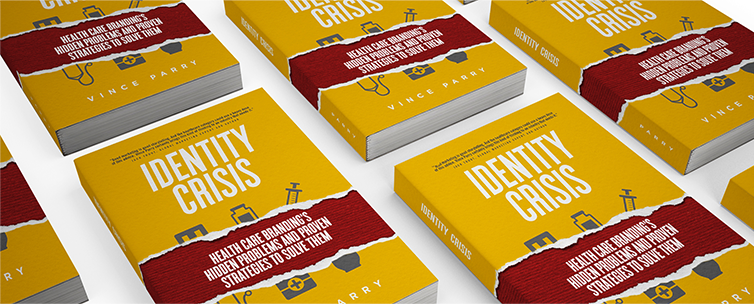NOW AVAILABLE





Buy the book from your favorite retail outlets



FOR BULK ORDERS
Special: Discounts available for bulk purchases of five or more copies. Inquire Here
Whether it’s a pain reliever for a headache, a life-saving operation, having a baby, or just a routine checkup, everyone in the developed world is touched by the healthcare industry in one way or another. As vital as this industry is to us all, branding expert Vince Parry sees fundamental problems first hand in the way healthcare companies and their advertising agencies market health and wellness brands. Identity Crisis highlights the many missteps, misnomers and missed opportunities for some of the biggest healthcare brands of our day, and offers solutions for avoiding these problems in the future. Among many observations, this book points out:
- The problems of using consumer-goods branding techniques in healthcare
- The pervasive fallacy that doctors aren’t influenced by healthcare marketing
- The enlightening power of branding or rebranding illnesses to defuse their stigma
Bringing over 30 years of expertise to bear, Vince Parry has written nothing less than the definitive book on healthcare branding: what to do and—just as importantly—what NOT to do for anyone involved or interested in an industry that is at the center of our lives.
Excerpts from IDENTITY CRISIS
Vince’s thoughts on the dilemma of healthcare branding
Something is amiss with healthcare branding. Everyone is uncomfortable with it but can’t figure out exactly why. And it’s not anything so isolated as a brand name that defies pronunciation or a TV campaign that asks you to believe people genuinely love their laxative. The problem is more insidious and pervasive than this, and it hides in plain sight. Healthcare branding has an identity crisis: a foundational uncertainty and confusion about its expected purpose and role in society. Should the branding of a treatment for psoriasis or diabetes or blood pressure avail itself of the proven processes used to brand beer, SUVs and mobile phones? Or should healthcare branding behave like a clinical bulletin from the front lines, detached from passion and sticking to the facts, ma’am, just the facts?
Vince’s thoughts on how illness determines identity
We do not see health as it is; we see health as we are. When consumers get sick, they become someone different. They might even say, “I’m not myself today.” People do not celebrate the buying process when they become ill. They are now forced to buy brands that they don’t want, but rather need. When faced with the prospect of, say, herpes, overactive bladder, or depression, consumers experience an alteration to their identity that affects the way they relate to brands in general, and healthcare brands specifically. Healthcare brands are about a protection of self, not a celebration like consumer brands. The best someone with an illness can hope for is a return to normalcy. In the case of mild illness, like a rash, normal can be relatively easy to achieve. But in the case of more chronic conditions, like diabetes or psoriasis, people’s identities must adjust to accommodate a new, if unwanted, self-characterization: a former self that is now routinely interrupted or altered forever by an Illness that is, respectively, chronically acute or chronic.
Vince’s thoughts on branding illnesses
Condition branding involves acknowledging or discovering pathologies behind human ills and behaviors and instilling them with an identity: a universally accepted name and/or acronym. Conditions like multiple sclerosis, bi-polar disorder, overactive bladder, AIDS, carpal tunnel syndrome, to name just a few, were once mythical, misunderstood sets of symptoms that puzzled and oppressed society. However, through condition branding we have come to acknowledge and understand them as legitimate illnesses worth studying and treating by professionals and having covered under insurance policies. We have neutralized the confusing power they had over us by giving them brand identities.
Vince’s thoughts on dysfunctional branding processes
Too many brand strategy maps resemble the convoluted schematic of how to electrically wire a house. Brand identity crises often occur because the branding strategy processes themselves suffer from multiple personality disorder: they have no idea what they want to be. Brand essence. Spike attributes. Brand character. Brand voice. Brand impact. Brand magnetism. Positioning. Brand aspiration. Brand truth. Brand ladder. The Unique Selling Proposition (USP). Brand pyramid. Brand values. In the best cases, the terms given to components of one agency’s brand identity strategy are really just a re-naming of the same things in others’ strategic models. In the worst cases, some agencies use a handful of the above terms in the same model like an ad-hoc strategy stew.
